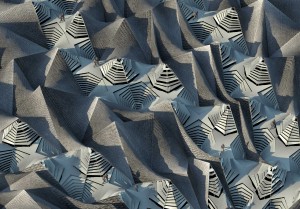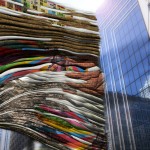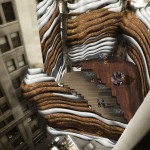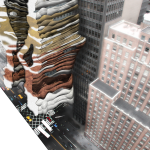“Whenever one can describe, between a number of statements, such a system of dispersion, whenever, between objects, types of statement, concepts, or thematic choices, one can define a regularity (an order, correlations, positions and functionings, transformations), we will say, for the sake of convenience, that we are dealing with a discursive formation – thus avoiding words that are already overladen with conditions and consequences, and in any case inadequate to the task of designating such a dispersion, such as ‘science’ ‘ideology’, ‘theory’, or ‘domain of objectivity’.” Michele Foucault
In an age of information and technology, how do we progress as a people? Our time defined by biological evolution has quite arguably ended, yet we continue to progress as a species. We possess advanced cognitive capabilities that have allowed us to manipulate matter into apparati; extensions of the human envelop. As a result we have been able to transcend the very fundamental environmental drivers of biological evolution and in the place of our physical bodies, the tool (both epistemological and technological) has subsumed the role of evolution. The tool is both epistemic and technological because these tools are both manipulations and articulations of physical matter as well as virtual ideas. Now in the silicon age, and with the advent of diverse inter-networking technologies tools have become connected through virtual domains and interfaces.
These technologies have also shifted the way through which we talk, share, and collaborate in order to undergo the process of reshaping the objects around us to suit immediate needs that our biological clock cannot keep up with. We participate in discourse, which as Foucault describes, is not simply a set of articulated propositions but rather the relationships between these propositions. Discourse, in-and-of-itself, is a precursor to knowledge, opening up the possibilities to illustrate “what we think we know is contingent on how we talk about it.”
Each discipline has its own discrete semiotic catalog of discussing the knowledge; architecture through drawings, diagrams, columns, walls, among other things. It is through these languages that we express our ability to understand (and control) the universe. Whether our epistemic understanding of the universe is true or not, we justify our manipulations of matter through the various theories and ideas we have constructed to give order to the universe; it is how we control. Our unique relationship to epistimae and techne is the manifestation of these various languages; discursive formations of bodies of knowledge and tectonic formations of materials as a representation of technology. The intertwining of the two, could possibly be illustrated by Sir Francis Bacon’s Novum Organon, which some argue marked the beginning of the scientific revolution. Through instrumentalist empiricism, Bacon posits that progress cannot be achieved by either the epistimae or the teche (although not explicitly in these terms), but by the relationship of these two, the method.
In many and most cases, we have struggled to find information to further understand the universe around us in some cases; and in others we have excelled in defining the laws and constraints of our immediate contexts; in places we cannot gain this level of control we typically assign supernatural identifiers (for example, God, to explain the creation of the uncertain beginning of the universe). We control, in the reality that is our own plane of existence, the universe through knowledge and our vast -scapes through techne. And our methods are retrieved, stored as an archive of some sort, and then passed down to apprentices, students, offspring, or other counterparts. It is the evolutionary process of information.
Take for example Rembrandt’s painting of praelector Dr. Nicolaes Tulp. An early commission to Rembrandt, the painting depicted an anatomy lesson involving the dissection of a male criminal (as such a dissection was only legally performed on male criminals considered outside of the Church and subject to public hanging). The anatomy lesson began with the forearm (unusual in most cases), but thought to be so because of new discoveries revolving the lymphatic system and white veins as described in a popular anatomical Latin text on the subject at the time.
The anatomy lesson is public to a group of individuals also included as subjects in the painting, however it can be alluded that there is a larger audience observing the dissection. This is not only a testament to the embedded curiosity of the human species, but as illustrated through the various media (books, posters, notebooks) in the painting, of our willingness to expand on our body of knowledge through the passing down or dissemination of knowledge. This intellectual lineage can be traced back for centuries with new methods and information arising as our technology exceedingly excels and progresses to new highs.
Whether or not we are headed in the correct direction towards a telos of understanding the Truth, we continue to develop theories and technologies that have casting increased the complexity of our world. And so I return to the question of ‘how do we progress as a people?” The biological equivalent of this is to evolve and meet the needs of the environmental context. Genetic speciation and the mechanisms for evolution are inherently tied to the environment as a primary driver for the evolutionary process to occur. What are the new mediums through which we define our ability to engage in discourse? Many theorists argue that, because we have replaced technological evolution in place of our slowed biological evolution, the role of technology will play an active role and more radically.
Jackob von Uexküll states, “All animal subjects, from the simplest to the most complex, are inserted into their environments to the same degree of perfection. The simple animal has a simple environment; the multiform animal has an environment just as richly articulated as it is.” The tick for example, although placed within a very complex world, is limited in its sensorial understanding of that world, and thus is subject to a less complex world due to its ability to only understand a limited number of stimuli and react accordingly.
The world however, and these states of the environment he speaks of, are not static in any sense of the word; they are continuously changing at rates and in ways we cannot imagine. The technology that we create (and soon that artificial intelligence will be capable of equally creating) will vastly change the complexity of our world. For this reason, a philosophical body of thought called post-humanism has emerged, with a number of different types. In order to meet the equally increasing complexity of the world, in order to become subjects of this new world order, we must as well adopt a vehicle through which we can become more complex: the body.





